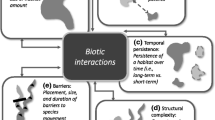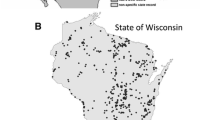Abstract
The need to understand how anthropogenic landscape alteration affects fauna populations has never been more pressing. The importance of developing an understanding of the processes behind local extinction is widely acknowledged, but inference from spatial patterns of fauna distribution continues to dominate. However, this approach is limited in its ability to generate strong predictions about future distributions and local extinctions, especially when population-level responses to landscape alteration are subject to long time lags. We review the potential for indices of physiological stress and condition to contribute to understanding of how landscape pattern affects species persistence. Such measures can indicate habitat quality from the perspective of the individual animal, and can reveal environmental stressors before their negative consequences begin to manifest at a population level. Spatial patterns of chronic stress may therefore yield valuable insight into how landscape alteration influences species. We propose that the emerging disciplines of conservation physiology and macrophysiology have much to offer spatial ecology, and have great potential to reveal the physiological pathways through which habitat alteration affects fauna populations and their persistence in fragmented landscapes.


Similar content being viewed by others
References
Apanius V (1998) Stress and immune defense. Advances in the Study of Behavior 27:133–153
Baguette M, Van Dyck H (2007) Landscape connectivity and animal behavior: functional grain as a key determinant for dispersal. Landscape Ecol 22:1117–1129
Benson TJ, Anich NM, Brown JD, Bednarz JC (2010) Habitat and landscape effects on brood parasitism, nest survival, and fledgling production in Swainson’s warblers. J Wildlife Manage 74:81–93
Bonier F, Moore IT, Martin PR, Robertson RJ (2009) The relationship between fitness and baseline glucocorticoids in a passerine bird. Gen Comp Endocrinol 163:208–213
Bourgeon S, Raclot T (2006) Corticosterone selectively decreases humoral immunity in female eiders during incubation. J Exp Biol 209:4957–4965
Brown DR, Sherry TW (2006) Food supply controls the body condition of a migrant bird wintering in the tropics. Oecologia 149:22–32
Buchanan KL (2000) Stress and the evolution of condition-dependent signals. Trends Ecol Evol 15:156–160
Burke DM, Nol E (1998) Influence of food abundance, nest-site habitat, and forest fragmentation on breeding ovenbirds. Auk 115:96–104
Carey C (2005) How physiological methods and concepts can be useful in conservation biology. Integr Comp Biol 45:4–11
Chalfoun AD, Thompson FR, Ratnaswamy JM (2002) Nest predators and fragmentation: a review and meta-analysis. Conserv Biol 16:206–318
Chown SL, Gaston KJ (2008) Macrophysiology for a changing world. Proc R Soc B 275:1469–1478
Chown SL, Gaston KJ, Robinson D (2004) Macrophysiology: large-scale patterns in physiological traits and their ecological implications. Funct Ecol 18:159–167
Cooke SJ, O’Connor CM (2010) Making conservation physiology relevant to policy makers and conservation practitioners. Conserv Lett 3:159–166
Cooke SJ, Suski CD (2008) Ecological restoration and physiology: an overdue integration. Bioscience 58:957–968
Davis AK (2005) Effect of handling time and repeated sampling on avian white blood cell counts. J Field Ornithol 76:334–338
Davis AK, Maney DL, Maerz JC (2008) The use of leukocyte profiles to measure stress in vertebrates: a review for ecologists. Funct Ecol 22:760–772
Debus SJS (2006) The role of intense nest predation in the decline of scarlet robins and eastern yellow robins in remnant woodland near Armidale, New South Wales. Pacific Conserv Biol 12:279–287
Elith J, Leathwick JR (2009) Species distribution models: ecological explanation and prediction across space and time. Annu Rev Ecol Evol Syst 40:677–697
Fahrig L (2003) Effects of habitat fragmentation on biodiversity. Annu Rev Ecol Evol Syst 34:487–515
Fischer J, Lindenmayer DB (2007) Landscape modification and habitat fragmentation: a synthesis. Global Ecol Biogeogr 16:265–280
Ford HA, Barrett GW, Saunders DA, Recher HF (2001) Why have birds in the woodlands of Southern Australia declined? Biol Conserv 97:71–88
Ford HA, Walters JR, Cooper CB, Debus SJS, Doerr VAJ (2009) Extinction debt or habitat change?: Ongoing losses of woodland birds in north-eastern New South Wales, Australia. Biol Conserv 142:3182–3190
Fowles JR, Fairbrother A, Fix M, Schiller S, Kerkvliet NI (1993) Glucocorticoid effects on natural and humoral immunity in mallards. Dev Comp Immunol 17:165–177
Gaston KJ, Chown SL, Calosi P, Bernardo J, Bilton DT, Clarke A, Clusella‐Trullas S, Ghalambor SK, Konarzewski M, Peck LS, Porter WP, Pörtner HO, Rezende EL, Schulte PM, Spicer JI, Stillman JH, Terblanche JS, van Kleunen M (2009) Macrophysiology: a conceptual reunification. Am Nat 174:595–612
Gross WB, Siegel HS (1983) Evaluation of the heterophil/lymphocyte ratio as a measure of stress in chickens. Avian Dis 27:972–979
Hangalapura BN, Nieuwland MGB, Reilingh GD, Buyse J, van den Brand H, Kemp B, Parmentier HK (2005) Severe feed restriction enhances innate immunity but suppresses cellular immunity in chicken lines divergently selected for antibody response. Poult Sci 84:1520–1529
Hinam HL, St. Clair CC (2008) High levels of habitat loss and fragmentation limit reproductive success by reducing home range size and provisioning rates of Northern saw-whet owls. Biol Conserv 141:524–535
Hinsley S (2000) The costs of multiple patch use by birds. Landscape Ecol 15:765–775
Hinsley SA, Hill RA, Bellamy PA, Harrison NM, Speakman JR, Wilson AK, Ferns PN (2008) Effects of structural and functional habitat gaps on breeding woodland birds: working harder for less. Landscape Ecol 23:615–626
Hutto RL (1990) Measuring the availability of food resources. Studies in Avian Biol 13:20–28
Janin A, Léna J, Joly P (2011) Beyond occurrence: body condition and stress hormone as integrative indicators of habitat availability and fragmentation in the common toad. Biol Conserv 144:1008–1016
Johnson MD (2007) Measuring habitat quality: a review. Condor 109:489–509
Kitaysky AS, Piatt JF, Wingfield JC, Romano M (1999) The adrenocortical stress-response of black-legged kittiwake chicks in relation to dietary restrictions. J Comparative Physiol B 169:303–310
Kupfer JA, Malanson GP, Franklin SB (2006) Not seeing the ocean for the islands: the mediating influence of matrix-based processes on forest fragmentation effects. Global Ecol Biogeogr 15:8–20
Lindström KM, Hawley DM, Davis AK, Wikelski M (2005) Stress responses and disease in three wintering house finch (Carpodacus mexicanus) populations along a latitudinal gradient. Gen Comp Endocrinol 143:231–239
MacHunter J, Wright W, Loyn R, Rayment P (2006) Bird declines over 22 years in forest remnants in southeastern Australia: Evidence of faunal relaxation? Canadian J Forest Res 36:2756–2768
Maron M (2007) Threshold effect of eucalypt density on an aggressive avian competitor. Biol Conserv 136:100–107
Maron M, Main A, Bowen M, Howes A, Kath J, Pillette C, McAlpine CA (2011) Relative influence of habitat modification and interspecific competition on woodland bird assemblages in eastern Australia. Emu 111:40–51
Marra PP, Holbertson RL (1998) Corticosterone levels as indicators of habitat quality: effects of habitat segregation in a migratory bird during the non-breeding season. Oecologia 116:284–292
Martin LB (2009) Stress and immunity in wild vertebrates: timing is everything. Gen Comp Endocrinol 163:70–76
Martinez-Mota R, Valdespino C, Sanchez-Ramos MA, Serio-Silva JC (2007) Effects of forest fragmentation on the physiological stress response of black howler monkeys. Anim Conserv 10:374–379
Mazerolle DF, Hobson KA (2002) Physiological ramifications of habitat selection in territorial male ovenbirds: consequences of landscape fragmentation. Oecologia 130:356–363
Mazerolle DF, Villard M (1999) Patch characteristics and landscape context as predictors of species presence and abundance: a review. Ecoscience 6:117–124
McEwen BS, Wingfield JC (2003) The concept of allostasis in biology and biomedicine. Horm Behav 43:2–15
Merino S, Martínez J, Barbosa A, Møller AP, de Lope F, Pérez J, Rodríguez-Caabeiro F (1998) Increase in a heat-shock protein from blood cells in response of nestling house martins (Delichon urbica) to parasitism: an experimental approach. Oecologia 116:343–347
Mortimer L, Lill A (2007) Activity-related variation in blood parameters associated with oxygen transport and chronic stress in little penguins. Aust J Zool 55:249–256
Newcomb Homan R, Regosin JV, Rodrigues DM, Reed JM, Windmiller BS, Romero LM (2003) Impacts of varying habitat quality on the physiological stress of spotted salamanders (Ambystoma maculatum). Animal Conserv 6:11–18
Paton PWC (1994) The effect of edge on avian nest success: how strong is the evidence? Conserv Biol 8:17–26
Patten MA, Kelly JF (2010) Habitat selection and the perceptual trap. Ecol Appl 20:2148–2156
Rangel-Negrin A, Alfaro JL, Valdez RA, Romano MC, Serio-Silva JC (2009) Stress in Yucatan spider monkeys: effects of environmental conditions on fecal cortisol levels in wild and captive populations. Animal Conserv 12:496–502
Robinson SK (1998) Another threat posed by forest fragmentation: reduced food supply. Auk 115:1–3
Rogers CM, Ramenofsky M, Ketterson ED, Nolan V, Wingfield JC (1993) Plasma corticosterone, adrenal mass, winter weather, and season in nonbreeding populations of dark-eyed juncos (Junco hyemalis hyemalis). Auk 110:279–285
Romero LM (2004) Physiological stress in ecology: lessons from biomedical research. Trends Ecol Evol 19:249–255
Romero LM, Wikelski M (2001) Corticosterone levels predict survival probabilities of Galapagos marine iguanas during El Nino events. Proc Natl Acad Sci USA 98:7366–7370
Ruiz G, Rosenmann M, Novoa FF, Sabat P (2002) Hematological parameters and stress index in rufous-collared sparrows dwelling in urban environments. Condor 104:162–166
Sapolsky RM, Romero LM, Munck AU (2000) How do glucocorticoids influence stress responses? Integrating permissive, suppressive, stimulatory, and preparative actions. Endocr Rev 21:55–89
Shanahan DF, Possingham HP, Riginos C (2010) Models based on individual level movement predict spatial patterns of genetic relatedness for two Australian forest birds. Landsacape Ecol 26:137–148
Stevenson RD, Tuberty SR, DeFur PL, Wingfield JC (2005) Ecophysiology and conservation: the contribution of endocrinology and immunology: introduction to the symposium. Integr Comp Bio 45:1–3
Stier KS, Almasi B, Gasparini J, Piault R, Roulin A, Jenni L (2009) Effects of corticosterone on innate and humoral immune functions and oxidative stress in barn owl nestlings. J Exp Biol 212:2085–2091
Strong AM, Sherry TW (2000) Habitat-specific effects of food abundance on the condition of ovenbirds wintering in Jamaica. J Anim Ecol 69:883–895
Suorsa P, Huhta E, Nikula A, Jantti A, Helle H, Hakkarainen H (2003) Forest management is associated with physiological stress in an old-growth forest passerine. Proc R Soc B-Biol Sci 270:963–969
Suorsa P, Helle H, Koivunen V, Huhta E, Nikula A, Hakkarainen H (2004) Effects of forest patch size on physiological stress and immunocompetence in an area-sensitive passerine, the Eurasian treecreepr (Certhis familiaris): an experiment. Proc R Soc B-Biol Sci 271:435–440
Van Horne B (1983) Density as a misleading indicator of habitat quality. J Wildl Manage 47:893–901
Vleck CM, Vertalino N, Vleck D, Bucher TL (2000) Stress, corticosterone, and heterophil to lymphocyte ratios in free-living adelie penguins. Condor 102:392–400
Wasser SK, Bevis K, Hanson E (1997) Noninvasive physiological measures of disturbance in the northern spotted owl. Conserv Biol 11:1019–1022
Watson DM (2011) A productivity-based explanation for woodland bird declines: poorer soils yield less food. Emu 111:10–18
Wenny DG, Clawson RL, Faaborg J, Sheriff SL (1993) Population density, habitat selection and minimum area requirements of three forest-interior warblers in central Missouri. Condor 95:968–979
Wikelski M, Cooke SJ (2006) Conservation physiology. Trends Ecol Evol 21:38–46
Wingfield JC, Kitaysky AS (2002) Endocrine response to unpredictable environmental events: stress or anti-stress hormones? Integ Comp Biol 42:600–609
Wingfield JC, Ramenofsky M (1997) Corticosterone and facultative dispersal in response to unpredictable events. Ardea 85:155–166
Wingfield JC, Ramenofsky M (1999) Hormones and the behaviorial ecology of stress. In: Balm PHM (ed) Stress physiology in animals. Sheffield Academic Press, Sheffield, pp 1–51
Wingfield JC, Hunt K, Breuner C, Dunlap K, Fowler GS, Freed L, Lepson J (1997) Environmental stress, field endocrinology, and conservation biology. In: Clemmons JR, Buchholz R (eds) Behavioral approaches to conservation in the wild. Cambridge University Press, Cambridge, pp 95–131
Wingfield JC, Maney DL, Breuner CW, Jacobs JD, Lynn S, Ramenofsky M, Richardson RD (1998) Ecological bases of hormone-behavior interactions: the “emergency life history stage”. Am Zool 38:191–206
Zanette L, Doyle P, Tremont SM (2000) Food shortage in small fragments: evidence from an area-sensitive passerine. Ecol 81:1654–1666
Acknowledgments
The authors thank A. Lill, D. Watson and J. Rhodes for helpful discussion of this topic, and H. Ford and an anonymous reviewer whose comments greatly improved the manuscript. This article was partly supported by a Early Career Researcher grant from The University of Queensland.
Author information
Authors and Affiliations
Corresponding author
Rights and permissions
About this article
Cite this article
Ellis, R.D., McWhorter, T.J. & Maron, M. Integrating landscape ecology and conservation physiology. Landscape Ecol 27, 1–12 (2012). https://doi.org/10.1007/s10980-011-9671-6
Received:
Accepted:
Published:
Issue Date:
DOI: https://doi.org/10.1007/s10980-011-9671-6




